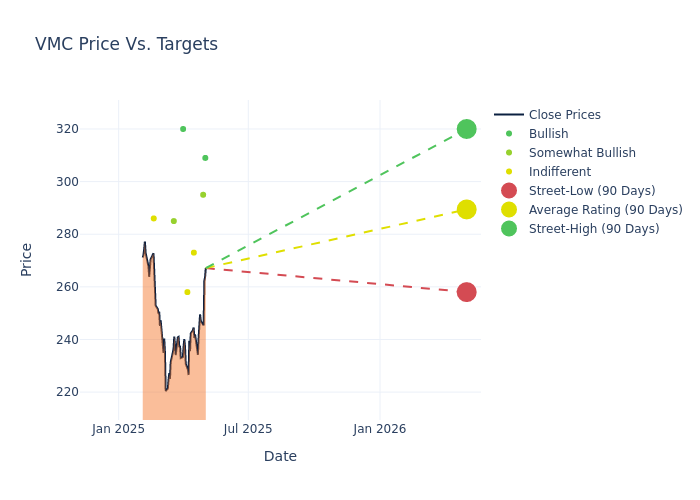
9 analysts have shared their evaluations of Vulcan Materials (NYSE:VMC) during the recent three months, expressing a mix of bullish and bearish perspectives.
In the table below, you'll find a summary of their recent ratings, revealing the shifting sentiments over the past 30 days and comparing them to the previous months.
| Bullish | Somewhat Bullish | Indifferent | Somewhat Bearish | Bearish | |
|---|---|---|---|---|---|
| Total Ratings | 3 | 2 | 4 | 0 | 0 |
| Last 30D | 1 | 0 | 0 | 0 | 0 |
| 1M Ago | 0 | 1 | 2 | 0 | 0 |
| 2M Ago | 2 | 1 | 0 | 0 | 0 |
| 3M Ago | 0 | 0 | 2 | 0 | 0 |
The 12-month price targets assessed by analysts reveal further insights, featuring an average target of $290.33, a high estimate of $320.00, and a low estimate of $258.00. This current average represents a 3.58% decrease from the previous average price target of $301.12.

Diving into Analyst Ratings: An In-Depth Exploration
In examining recent analyst actions, we gain insights into how financial experts perceive Vulcan Materials. The following summary outlines key analysts, their recent evaluations, and adjustments to ratings and price targets.
| Analyst | Analyst Firm | Action Taken | Rating | Current Price Target | Prior Price Target |
|---|---|---|---|---|---|
| Brian Brophy | Stifel | Raises | Buy | $309.00 | $287.00 |
| Patrick Tyler Brown | Raymond James | Lowers | Outperform | $295.00 | $300.00 |
| Angel Castillo | Morgan Stanley | Lowers | Equal-Weight | $273.00 | $300.00 |
| Steven Fisher | UBS | Lowers | Neutral | $258.00 | $343.00 |
| Garik Shmois | Loop Capital | Lowers | Buy | $320.00 | $325.00 |
| Adrian Huerta | JP Morgan | Lowers | Overweight | $285.00 | $290.00 |
| Brian Brophy | Stifel | Announces | Buy | $287.00 | - |
| Angel Castillo | Morgan Stanley | Raises | Equal-Weight | $300.00 | $295.00 |
| Mike Dahl | RBC Capital | Raises | Sector Perform | $286.00 | $269.00 |
Key Insights:
- Action Taken: In response to dynamic market conditions and company performance, analysts update their recommendations. Whether they 'Maintain', 'Raise', or 'Lower' their stance, it signifies their reaction to recent developments related to Vulcan Materials. This insight gives a snapshot of analysts' perspectives on the current state of the company.
- Rating: Providing a comprehensive analysis, analysts offer qualitative assessments, ranging from 'Outperform' to 'Underperform'. These ratings reflect expectations for the relative performance of Vulcan Materials compared to the broader market.
- Price Targets: Analysts gauge the dynamics of price targets, providing estimates for the future value of Vulcan Materials's stock. This comparison reveals trends in analysts' expectations over time.
For valuable insights into Vulcan Materials's market performance, consider these analyst evaluations alongside crucial financial indicators. Stay well-informed and make prudent decisions using our Ratings Table.
Stay up to date on Vulcan Materials analyst ratings.
Unveiling the Story Behind Vulcan Materials
Vulcan Materials is the United States' largest producer of construction aggregates (crushed stone, sand, and gravel). Its largest markets include Texas, California, Virginia, Tennessee, Georgia, Florida, North Carolina, and Alabama. In 2024, Vulcan sold 219.9 million tons of aggregates, 13.6 million tons of asphalt mix, and 3.6 million cubic yards of ready-mix. As of Dec. 31, 2023, the company had nearly 16 billion tons of aggregates reserves.
Key Indicators: Vulcan Materials's Financial Health
Market Capitalization Analysis: With a profound presence, the company's market capitalization is above industry averages. This reflects substantial size and strong market recognition.
Revenue Growth: Vulcan Materials displayed positive results in 3M. As of 31 March, 2025, the company achieved a solid revenue growth rate of approximately 5.75%. This indicates a notable increase in the company's top-line earnings. In comparison to its industry peers, the company stands out with a growth rate higher than the average among peers in the Materials sector.
Net Margin: Vulcan Materials's net margin lags behind industry averages, suggesting challenges in maintaining strong profitability. With a net margin of 7.89%, the company may face hurdles in effective cost management.
Return on Equity (ROE): The company's ROE is below industry benchmarks, signaling potential difficulties in efficiently using equity capital. With an ROE of 1.59%, the company may need to address challenges in generating satisfactory returns for shareholders.
Return on Assets (ROA): The company's ROA is below industry benchmarks, signaling potential difficulties in efficiently utilizing assets. With an ROA of 0.76%, the company may need to address challenges in generating satisfactory returns from its assets.
Debt Management: Vulcan Materials's debt-to-equity ratio stands notably higher than the industry average, reaching 0.67. This indicates a heavier reliance on borrowed funds, raising concerns about financial leverage.
The Significance of Analyst Ratings Explained
Ratings come from analysts, or specialists within banking and financial systems that report for specific stocks or defined sectors (typically once per quarter for each stock). Analysts usually derive their information from company conference calls and meetings, financial statements, and conversations with important insiders to reach their decisions.
Some analysts publish their predictions for metrics such as growth estimates, earnings, and revenue to provide additional guidance with their ratings. When using analyst ratings, it is important to keep in mind that stock and sector analysts are also human and are only offering their opinions to investors.
Which Stocks Are Analysts Recommending Now?
Benzinga Edge gives you instant access to all major analyst upgrades, downgrades, and price targets. Sort by accuracy, upside potential, and more. Click here to stay ahead of the market.
This article was generated by Benzinga's automated content engine and reviewed by an editor.